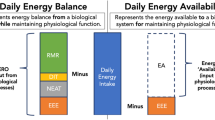Abstract
The evolutionary and biological significance of adaptive, homeostatic forms of heat production (thermogenesis) is reviewed. After summarizing the role and selective value of thermogenesis in body temperature regulation (shivering and non-shivering thermogenesis) and the febrile response to infection (fever), the review concentrates on diet-induced thermogenesis (DIT). Animal studies indicate that DIT evolved mainly to deal with nutrient-deficient or unbalanced diets, and re-analysis of twelve overfeeding studies carried out between 1967 and 1999 suggests the same may be so for humans, particularly when dietary protein concentration is varied. This implies that the role of DIT in the regulation of energy balance is secondary to its function in regulating the metabolic supply of essential nutrients. However, individual differences in DIT are much more marked when high- or low-protein diets are overfed, and this could provide a very sensitive method for discriminating between those who are, in metabolic terms, resistant and those who are susceptible to obesity.
Similar content being viewed by others
Author information
Authors and Affiliations
Corresponding author
Additional information
Review based on the EASO Wasserman Prize Lecture delivered at the 9th European Congress of Obesity, Milan, June 1999.
Rights and permissions
About this article
Cite this article
Stock, M. Gluttony and thermogenesis revisited. Int J Obes 23, 1105–1117 (1999). https://doi.org/10.1038/sj.ijo.0801108
Published:
Issue Date:
DOI: https://doi.org/10.1038/sj.ijo.0801108
- Springer Nature Limited
Keywords
This article is cited by
-
Metabolic Factors Determining the Susceptibility to Weight Gain: Current Evidence
Current Obesity Reports (2020)
-
Effect of Over- and Underfeeding on Body Composition and Related Metabolic Functions in Humans
Current Diabetes Reports (2019)
-
Changes in Energy Expenditure with Weight Gain and Weight Loss in Humans
Current Obesity Reports (2016)
-
Water-induced thermogenesis and fat oxidation: a reassessment
Nutrition & Diabetes (2015)
-
Effects of breeds and dietary protein levels on the growth performance, energy expenditure and expression of avUCP mRNA in chickens
Molecular Biology Reports (2013)




